Following the Parliamentary and Health Service Ombudsman (PHSO, 2013) report Midwifery supervision and regulation: recommendations for change and the Nursing and Midwifery Council (NMC, 2015a) response to it, decisions have been made to seek the removal of the regulation currently in place for midwives through statutory supervision. The NMC (2015a) accepted the two principles identified in the reports: that midwifery supervision and regulation should be separated, and that the NMC should be in direct control of regulatory activity.
However, in 2014 in Wales a new model of supervision (the Future Proofing Model) was launched, which included the process of group supervision (Ness and Richards, 2014). The model involved the appointment of suitably prepared midwives to work full-time as a supervisors of midwives (SoMs) for rotational 18-month periods. These SoMs are solely dedicated to the role of supervision and an all-Wales 24-hour on-call rota provides regulatory advice and guidance. Midwives have their Annual Supervisory Review (ASR) through group supervision, and the full-time SoMs facilitate the sharing of best practice based on an action learning approach (Machin and Pearson, 2014).
As the new model led to significant changes in supervision practice, a number of ways to evaluate it were devised, implemented and analysed. This paper reports on all four sources of data from evaluations and audits that were available to the Local Supervising Authority (LSA) at the time of writing. This included extracted Welsh data from a UK-wide LSA audit, which was administered via an internet survey platform; these data comprised the responses from all the 84 midwife respondents from Wales. An audit by lay reviewers working on behalf of the Welsh LSA was included, as were the findings from a focus group involving 17 SoMs in Wales who were in post at the time of writing. Finally, 343 anonymous ASR evaluation forms received by the LSA from midwives in Wales during 2014–15 were analysed and included in the overall evaluation.
Following on from a previous paper (Lavery et al, 2016), this paper presents the findings from all four data sets, which evaluated the contribution of group supervision in midwifery in Wales in 2014–15.
Supervision of midwifery: Analysis of survey data from Welsh midwives
In December 2014, the Local Supervisory Authority Midwifery Officers (LSAMO) Forum UK sent out a questionnaire across the UK to survey all midwives about their views and experiences of supervision, with a 6-week timeframe for completion. The response rate in Wales was slightly under 6%. This is a disappointingly low response rate; however, it is important to consider what elements may have affected this. It should be noted that the survey was open over the Christmas and New Year period, which may have been a busy time for the midwives in terms of both their professional and personal lives. A significant proportion of midwives also work part-time and varying shift patterns, therefore opportunities for them to meet their SoM and/or see the poster advertising the survey within the tight timeframe may have been limited. Finally, email is used by employers and many other people and organisations to communicate with NHS staff, and it is worth considering that it is easy to miss an email when it appears among many others.
The NMC requires that ‘at least once a year, a supervisor of midwives meets each midwife for whom she is the named supervisor of midwives to review the midwife's practice and to identify her education needs' (NMC, 2012: 14). The respondents to the survey seemed to be compliant with this, with all having had their review in the previous practice year (April to April). The literature identified several potential benefits of supervision, including improving practice and enhancing professionalism, and these were explored in the survey, where midwives were invited to select as many answers as applied regarding topics discussed at their last review (Figure 1).
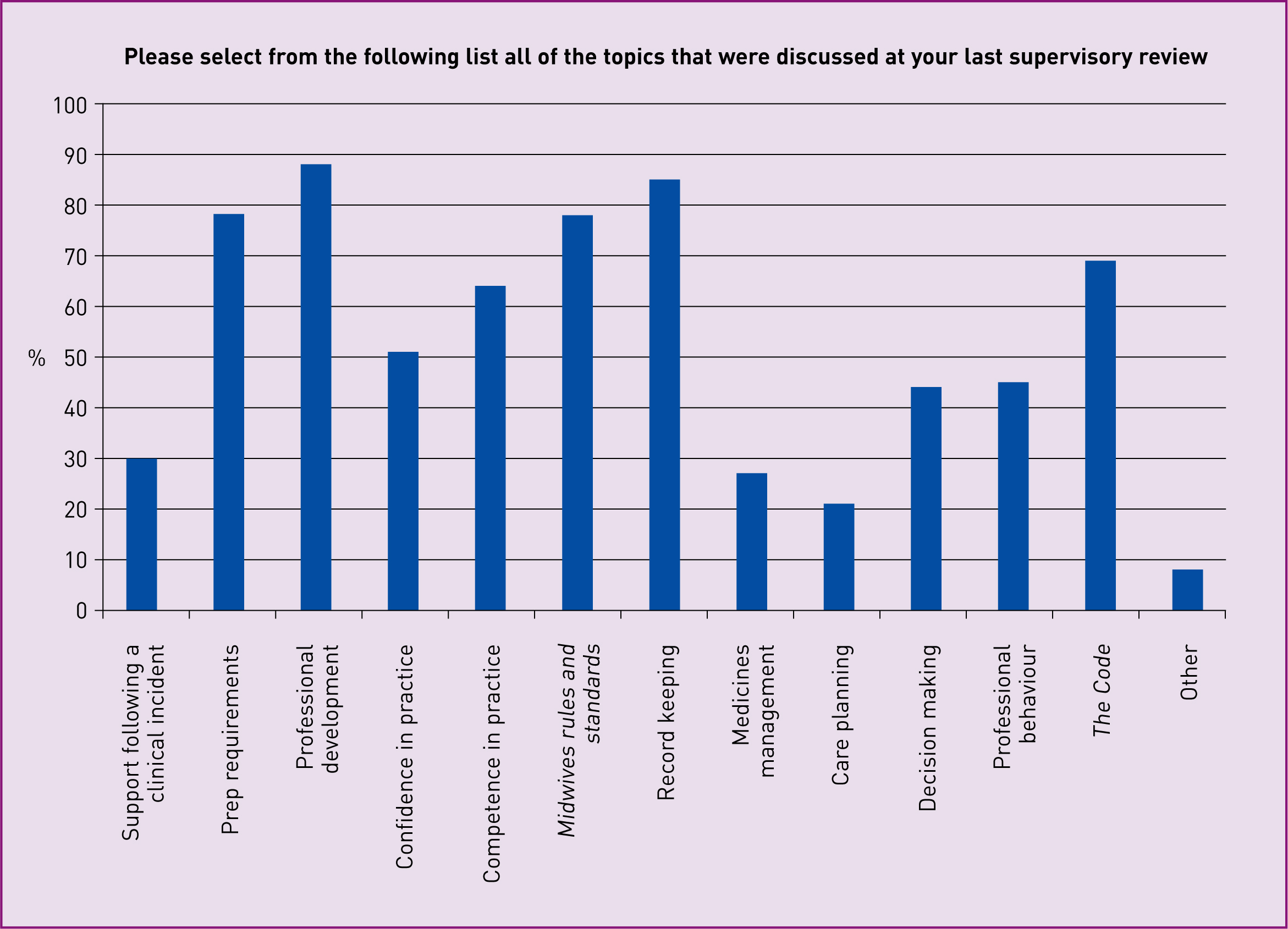
Respondents who answered ‘other’ were asked to provide details. The topics were noted as: audit, preceptorship, NMC revalidation, new guidelines, and practice changes. It would, therefore, seem that the topics discussed at the ASR are exactly the same as those that might arise in group clinical supervision and in action learning.
The midwives were also asked ‘How satisfied are you with your supervisory review?’ Responses were given on a three-point Likert scale where 1 = poor, 2 = satisfactory and 3 = excellent, and respondents were asked to attribute these points to their satisfaction with the venue, privacy, confidentiality, timing, content, advice, guidance, and feedback on performance. Figure 2 shows that the midwives were generally satisfied with their supervisory reviews; over 87% of respondents reported that all aspects were satisfactory or excellent.
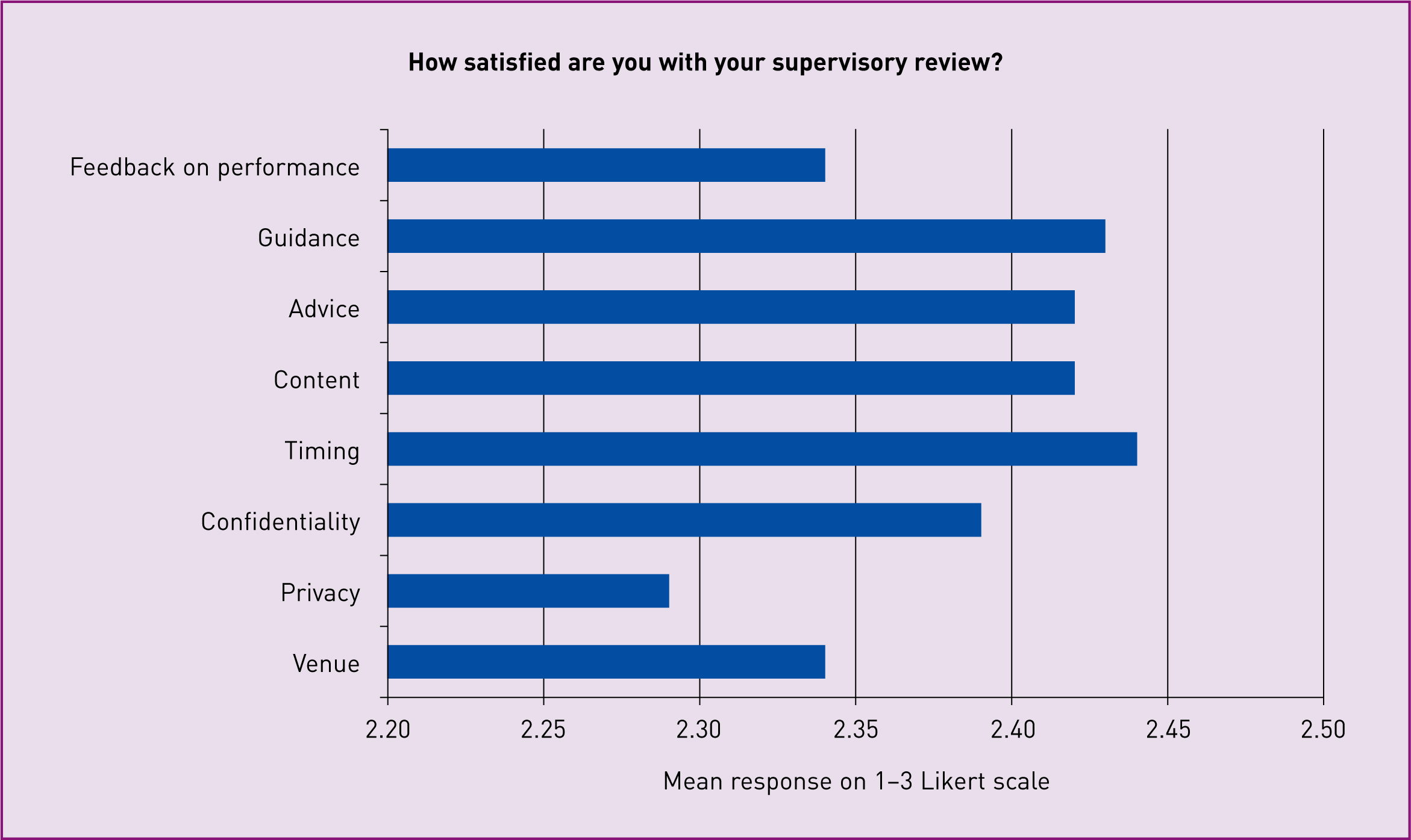
Eighteen of the respondents in Wales identified themselves as SoMs and, when asked in the survey to identify the three main reasons why they are SoMs, all referred to ‘improving standards, supporting midwives and protecting the public’.
In a later question, all respondents were asked to offer free-text comments about statutory supervision in their workplace. The themes arising from these statements that were related to the Future Proofing Model are:
Changes in supervision: Uncertainty
Some of the respondents expressed their uncertainty about the changes related to the launch of the new Future Proofing Model in the preceding 4 months. It is understandable that there was some uncertainty in the early months of the new model, and comments included:
‘Supervision used to be one-on-one, it is now a group supervision and I'm not sure how that's going to work, however I have not attended one yet so [I am] reluctant to comment positively or negatively at this point.’ (Respondent 20)
‘Query whether having group supervision allows enough time and confidentiality to discuss staff concerns/issues in depth.’ (Respondent 31)
Changes in supervision: Benefits
Some respondents were far more positive about the changes:
‘There is much more of a presence in the new role. Lots of emails and communication, offers of drop-in sessions etc. I think the service has improved.’ (Respondent 26)
‘The new model appears to be working well.’ (Respondent 36)
A number of the comments regarding the benefits of the new model related to group supervision in particular:
‘I feel the change is more effective than the one-on-one annual reviews.’ (Respondent 14)
‘Group supervision appears to be working well and I feel my needs are met by this kind of supervision. My supervisor also offers one-to-one supervision if I should need it.’ (Respondent 39)
Changes in supervision: Drawbacks
There were some comments relating to perceived drawbacks of the new model. Some respondents were unsure or negative about group supervision:
‘Group supervision was useful, however the dynamics could be quite different depending who was present within group supervision.’ (Respondent 19)
‘Preferred one-to-one supervision rather than groups.’ (Respondent 32)
Again, it would have been helpful to have had more explanation for these midwives' feelings. However, the majority of the respondents were positive about the benefits of supervision in midwifery, including its role in supporting high standards, safety, autonomy, monitoring practice and protecting the public. This positivity could be considered by health boards or clinical commissioning groups when exploring the development of an effective revalidation process for nurses and midwives.
Group supervision in Wales: Lay reviewers' audit
As part of the LSA Lay Reviewers' Audit Report of April 2015 (Healthcare Inspectorate Wales, 2015), the lay reviewers undertook an audit of group supervision. The objective set for the audit was to ensure group supervision is of sufficient quality to protect the public and to improve the service offered to women and their families.
The lay reviewers undertook a review of NMC and LSA regulation and guidance on supervision for midwives. The NMC (2015b)Code and revalidation plans were also reviewed, in order to help shape future recommendations. The lay reviewers interviewed two SoMs who had experience of facilitating group supervision sessions for ASR. They also interviewed four midwives, two of whom had completed their ASR as part of group supervision and two who had completed their own ASRs in one-to-one meetings but who had also attended a group supervision session on the day they were interviewed. All four midwives had an up-to-date ASR and had attended a supervision meeting in the last year; three of the five SoMs and midwives, when asked, were familiar with the ASR Guidance Q&A.
‘The data suggest group supervision may be a more open and transparent process than its predecessor’
The lay reviewers stated that the interviews provided them with a good deal of information about how SoMs and midwives are experiencing the reality of group supervision. Given the remit of the audit, they aimed to identify emerging themes on how group supervision addresses the protection of the public, improving service quality and incorporating women's feedback. In addition, they looked at the positives and challenges posed by the delivery of group supervision.
Themes were identified under two headings: the role of the SoM and the effectiveness of the process.
Findings from the audit were:
The lay reviewers found that group supervision enables midwives to raise concerns and there is no evidence that midwives can ‘hide’ in the group; the data suggest it may be a more open and transparent process than its predecessor. However, it is clear that midwives still have access to SoMs on a one-to-one basis if they wish to raise concerns about their own or colleagues' practice. The audit identified two specific examples of the sharing of best practice, which suggests group supervision can and does facilitate this, but it was unclear whether this is systemically embedded in the approach. The lay reviewers were able to identify several examples of how group supervision could support improved service quality, and one where an issue of protection of the public had been addressed as a result of group supervision. It is possible that this may not have been apparent under the previous format.
Group supervision in Wales: Focus group with 17 Welsh SoMs
During preparation of a report into group supervision commissioned by Healthcare Inspectorate Wales (Darra, 2015), it became clear that the perspectives of the SoMs who had been conducting group supervision were essential. All 17 Welsh SoMs agreed to discuss group supervision at their meeting on 1 May 2015. They were guaranteed anonymity regarding their responses, both in the report and in any further publications arising from it. They were asked to simply discuss their experiences with group supervision and the whole conversation, lasting just over 45 minutes, reflected their experiences. All the participants contributed to the discussion, which was audio recorded with consent and it was transcribed verbatim for analysis, to contribute to the review commissioned by Healthcare Inspectorate Wales (Darra, 2015). Within 2 weeks of the focus group discussion taking place, all participants were sent the full transcription of the conversation and none wished to withdraw their contribution.
Following a brief analysis of the data, using Attride-Stirling's (2001) approach to thematic analysis, there were four global themes that emerged from the data:
Better than expected
The strongest theme in the data from the focus group was a general agreement that the group supervision was better than the SoMs or the midwives had expected it to be.
‘From my experience with the midwives, they've been very much more engaged with the process than I thought they'd be and much more positive about it. That's the people that have attended have been very positive after it; people who are waiting to attend have been a bit anxious, but once they've attended I feel the feedback's been very positive. And it's an opportunity for them to engage.’ (SoM 3)
‘I've got to say there were quite a few reservations with the midwives regarding group supervision where I work. However, following attendance, I've got to say, they valued it and because they felt valued. And they were able to discuss things in a very confidential arena then. And they are looking forward to coming back this year. And I valued it as well, because I learnt, which informed me of the way to move forward as well for this year.’ (SoM 9)
Organisational issues
Since the implementation of the Future Proofing Model and the initiation of group supervision, there have been approximately 200 groups held across Wales. However, many of the SoMs in the focus group talked about how it had been difficult, at times, to arrange the groups for supervision. This is not surprising, given the potential for difficulties in health professionals being ‘released’ from their day-to-day duties (Hughes, 2005; Morgan et al, 2008).
‘One of our biggest problems, and I expect it was the same in other Health Boards, is getting people to come, that's the biggest problem, although it's well evaluated, everybody likes it, it's just they still haven't got the time to be released to come.’ (SoM 16)
Of course, midwives have always needed to negotiate and organise the time to attend their ASR when it was conducted on a one-to-one basis, but it is possible that arranging for groups of midwives to attend together poses additional organisational challenges. There were extensive sections of discussion in the focus group around how the SoMs organised the groups, which was not easy at times:
‘I started sending letters to their home address but I just couldn't keep up with the volume of work. You know, that was my preferred option, but I just didn't have enough time, so I've changed to… I do email to their NHS email account. More and more midwives, I think, are accessing their emails because we've been telling them this is how—you know, we do send appointment dates out, so the… supervisors in the Health Boards that have been saying those messages for months and months, so I wouldn't say it's perfect, but it is getting better!’ (SoM 5)
Others had clearly worked out strategies that were working fairly well:
‘I always get them to book—when I send out the letter I ask them to contact me to book on so I know how many are going to be there and probably only two occasions had midwives that haven't turned up, so most of them do turn up.’ (SoM 3)
The model has now been in place for almost a year and, if it continues, one might expect that the organisational aspects of group supervision will continue to improve, but this remains to be seen.
Leading the groups
All the respondents in the focus group were experienced midwives, with some of them being experienced SoMs. Some were new SoMs who had undertaken some training in action learning and group supervision in their recent Preparation of SoMs programme. A small number were currently undertaking that programme and had not yet held their own group supervision groups, but they had attended at least one. There was, perhaps inevitably, some discussion about the challenges of facilitating group supervision and the need for ground rules:
‘I think that the benefit of working in a group is, if you have less vocal members of the group, they're brought in on a conversation because the conversation is a conversation that's going around… The people you don't think are going to communicate particularly well, by the end of the session they're really contributing and I think that that's probably the bonus of doing it this way as opposed to any other way, because people are sort of drawn out of themselves, ’cause you have to respond, if somebody asks you a question, it sort of gains momentum doesn't it?’ (SoM 14)
‘And I suppose that's where setting the ground rules come into it with group supervision, is that you say that right at the beginning, isn't it? That everybody has a perspective and everybody has a voice, so in a subtle way you're basically saying to those individuals that you know are going to be a bit more vocal: now pipe down a little bit so that you allow your colleagues that maybe find it a bit harder to say what they need to say, which is equally as valued as everybody else. So I think you need to have a cunning plan in your ground rules.’ (SoM 8)
Other SoMs thought that they needed to keep the discussion focused on the whole group, especially when one of the group members might have been seen as an ‘expert’, for example, when a teacher was in the group. However, despite these concerns, it appeared that the SoMs in the focus group were not overly concerned about their ability to conduct and facilitate the groups.
Professional practice
There were a number of references to professional accountability to attend supervisory review, as well as midwives' accountability under the Code (NMC, 2015b), the Midwives rules and standards (NMC, 2012) and to the forthcoming requirements of NMC revalidation. SoM 16 expressed this well when she referred to how group supervision seemed to be initially an attempt to improve the ASR completion rates. She also seemed to be worried that the group supervision will become a ‘counselling session’ at which she might forget to check all the items that she needs to review as a SoM:
‘…as a vehicle to complete the Annual Supervisory Review process and all that entailed, which was 35 hours of CPD, your practice hours, your portfolio checking, to discuss the Code, to discuss the medicines management and all the things on the first page. That's all it ever was for, and it was to make it effective and efficient, and if you did five all in one go, it was a lot quicker than doing one. But out of that came the rest… peer support… group learning… everything else, so I think lately I have begun to wonder whether it's growing into something that it was never meant to be? The side effects are very good to the peer support, the group learning, the “oh I didn't know there was that course” and “let me have a look at your portfolio”, that's excellent but… to me it's still a form of ensuring that midwives are fit for practice and stay on the register and for a supervisor to sign her ItP [Intention to Practise]. That's all I think, I think the danger is changing group supervision into a counselling session, an action learning set, and forgetting to check the midwife's CPD, portfolio and practice hours.’ (SoM 16)
‘Another opportunity that comes out of it is you know when you're going through and you're talking about the documents related to the NMC, I find that really valuable, to be able to just talk about revalidation and, you know, because people don't even know what's going on.’ (SoM 4)
The findings from the focus group with 17 SoMs, undertaken 9 months into the Future Proofing Model of supervision, demonstrated some of what may be seen as expected challenges of changing practice to embrace a completely new process. The SoMs highlighted some of the difficulties in organising people to come together in groups. This may have been particularly difficult, as they were dealing with people working shift patterns covering a 24-hour, 7-day service, as well as ‘on-calls’ in some cases. However, they frequently referred to how they and their supervisees felt that the group meetings had gone better than they had expected, and that learning from each other was particularly encouraging and should not be lost despite the planned proposals for change.
Group supervision in Wales: ASR evaluation forms
There were several strands of work that were ongoing as part of the Future Proofing Model throughout 2013 and 2014; one of these was the implementation of group supervision and another was the reformatting of the ASR form, which is completed by midwives prior to their ASR meeting (whether on an individual one-to-one basis or in a group). As part of its ongoing monitoring responsibilities, the LSA routinely asks all midwives in Wales to complete an evaluation form after their ASR meeting. These forms were also updated and reformatted in late 2014. The findings from these evaluations provide some illuminating information about group supervision.
Figure 3 relates to the 27 evaluations received by the LSA by 29 October 2014. When asked questions about the ASR form, the ASR meeting and the ASR process, the majority of respondents (n=24, 88.9%) rated the ASR (group) meeting as ‘excellent’ in terms of it being beneficial to their practice. Only one respondent rated the group supervision as ‘poor’ (in response to questions 2 and 4), stating that s/he preferred a one-to-one meeting.
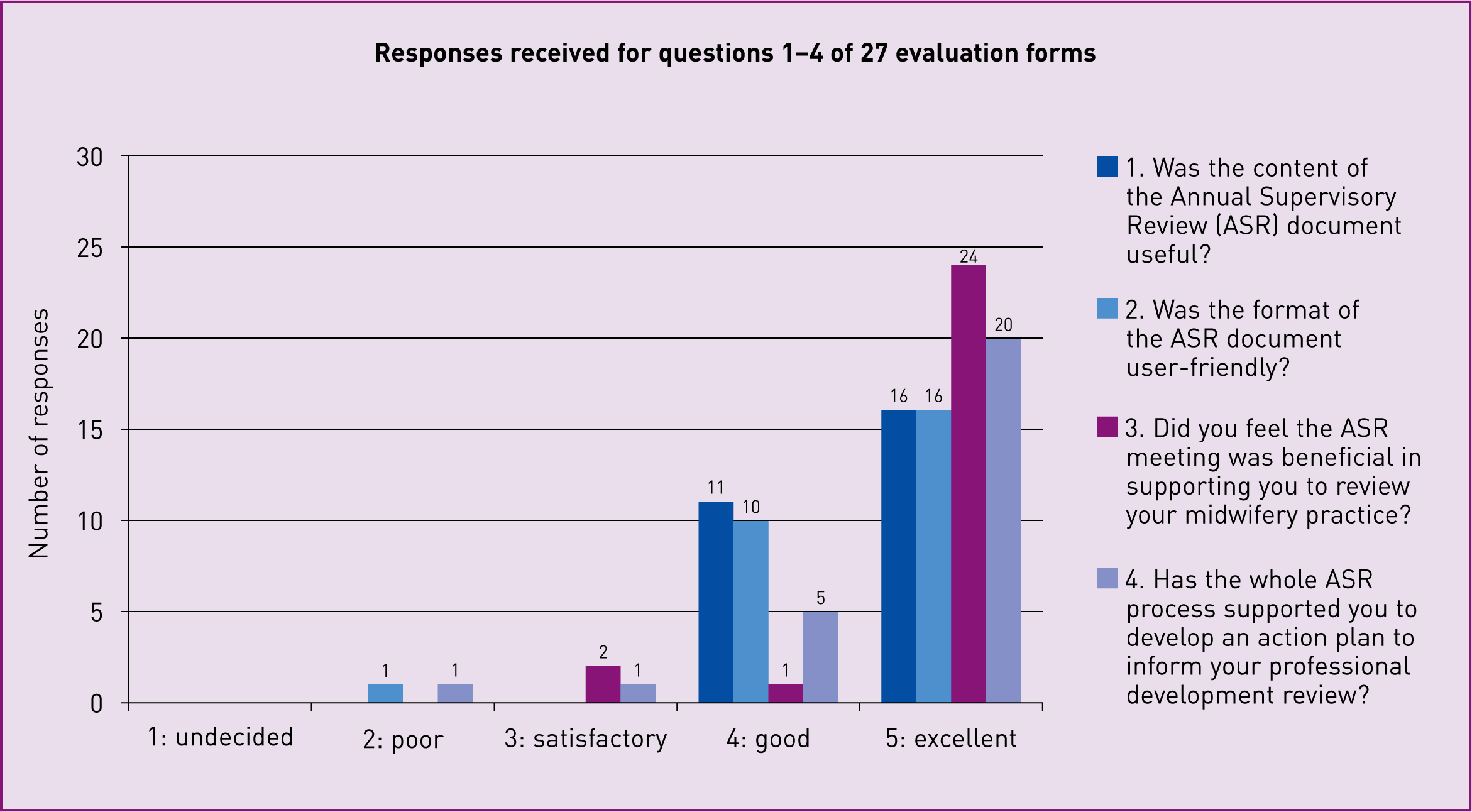
Figure 4 relates to the 37 evaluations received by the LSA between 29 October 2014 and 17 February 2015 (submitted on a newly designed evaluation form). Findings from these 37 respondents also demonstrate high satisfaction with group supervision. A clear majority (n=33, 89.2%) checked box 5 (high satisfaction) for question 1 and question 4. The free-text comments stated that the highlights were ‘group discussion’, the ‘exchange of views/opinions’ and ‘sharing experiences’.
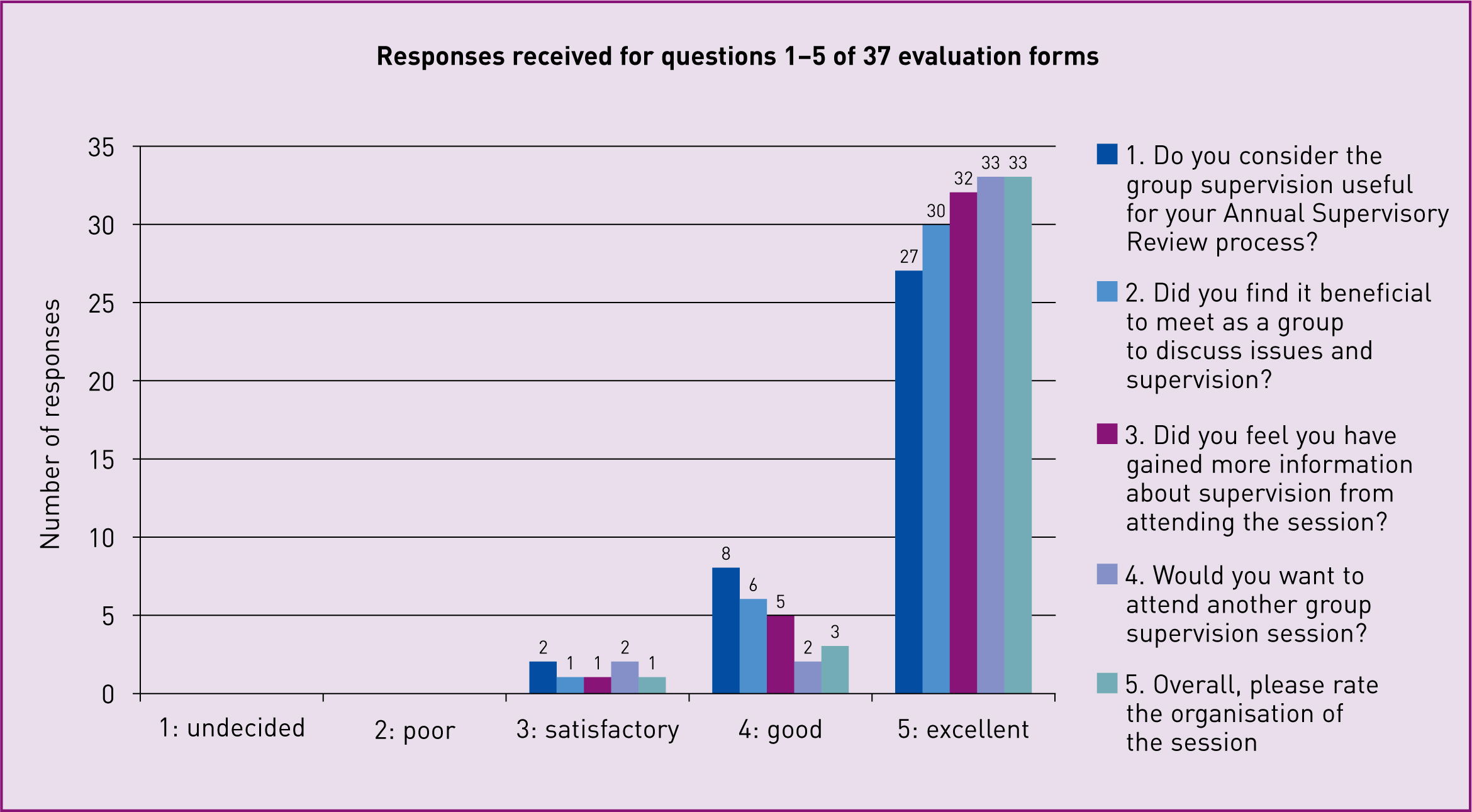
Figure 5 relates to the 186 evaluation forms of the old design that were received between 30 October 2014 and 17 February 2015. Again, the majority of respondents checked box 5 (excellent) to the first four questions. In particular, when asked whether the ASR group meeting was beneficial in supporting them to review midwifery practice, 96.8% (n=180) of respondents responded with either ‘good’ or ‘excellent’, 3.2% (n=6) of respondents were satisfied, no one felt the ASR was poor and only one person (0.5%) was undecided.
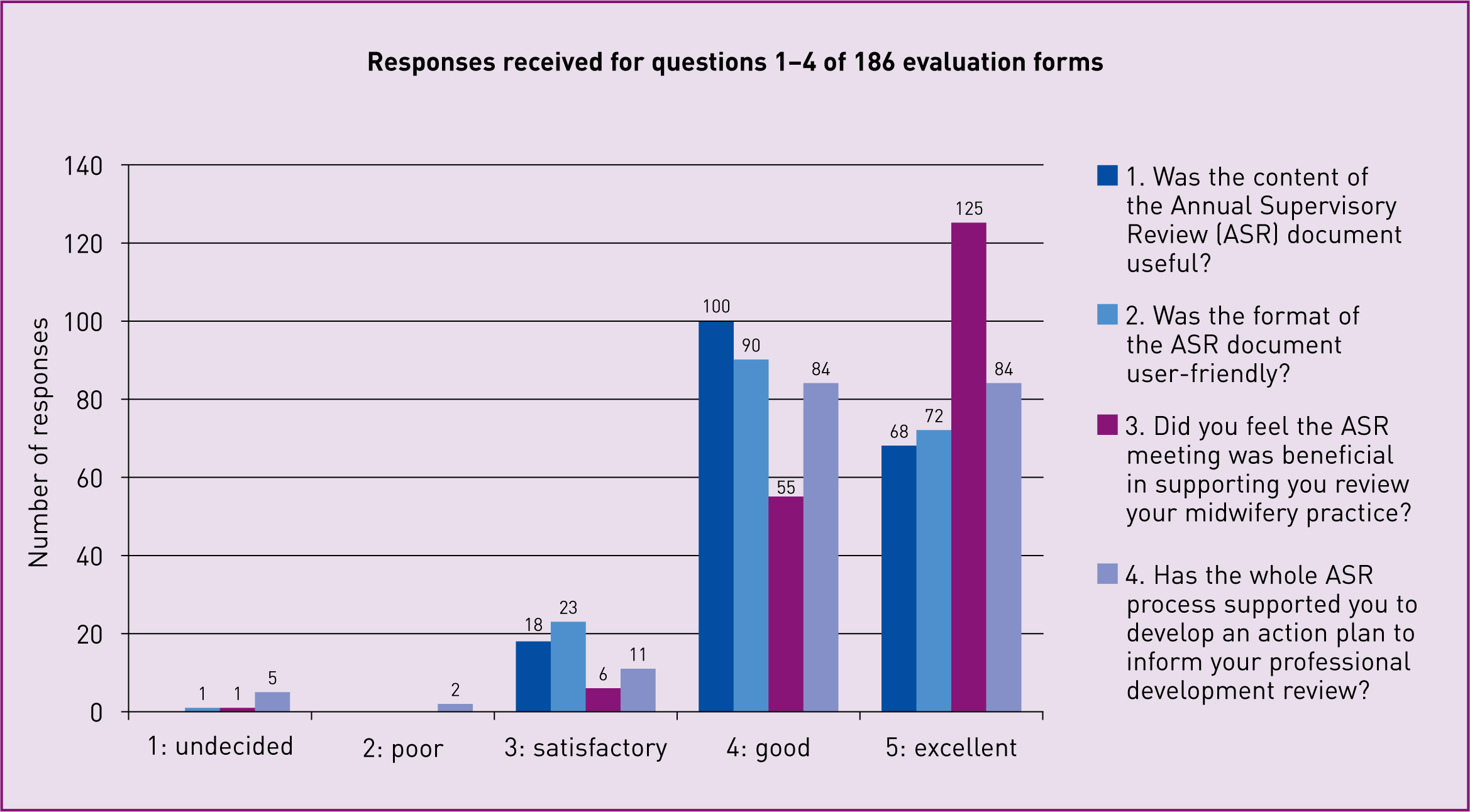
When asked whether the whole ASR process has supported them in developing an action plan to inform their professional development review (PDR), 90.3% (n=168) responded with either ‘good’ or ‘excellent’.
Figure 6 relates to the 93 evaluation forms received between 17 February 2015 and 25 June 2015. When asked whether the ASR group meeting was beneficial in supporting them to review their midwifery practice, 82.8% (n=77) of respondents responded with either ‘good’ or ‘excellent’, 3.2% (n=3) were ‘satisfied’ and only one person (1.1%) felt the ASR meeting was ‘poor’. When asked whether the whole ASR process had supported them in developing an action plan to inform their PDR, 80.6% (n=75) responded with either ‘good’ or ‘excellent’.
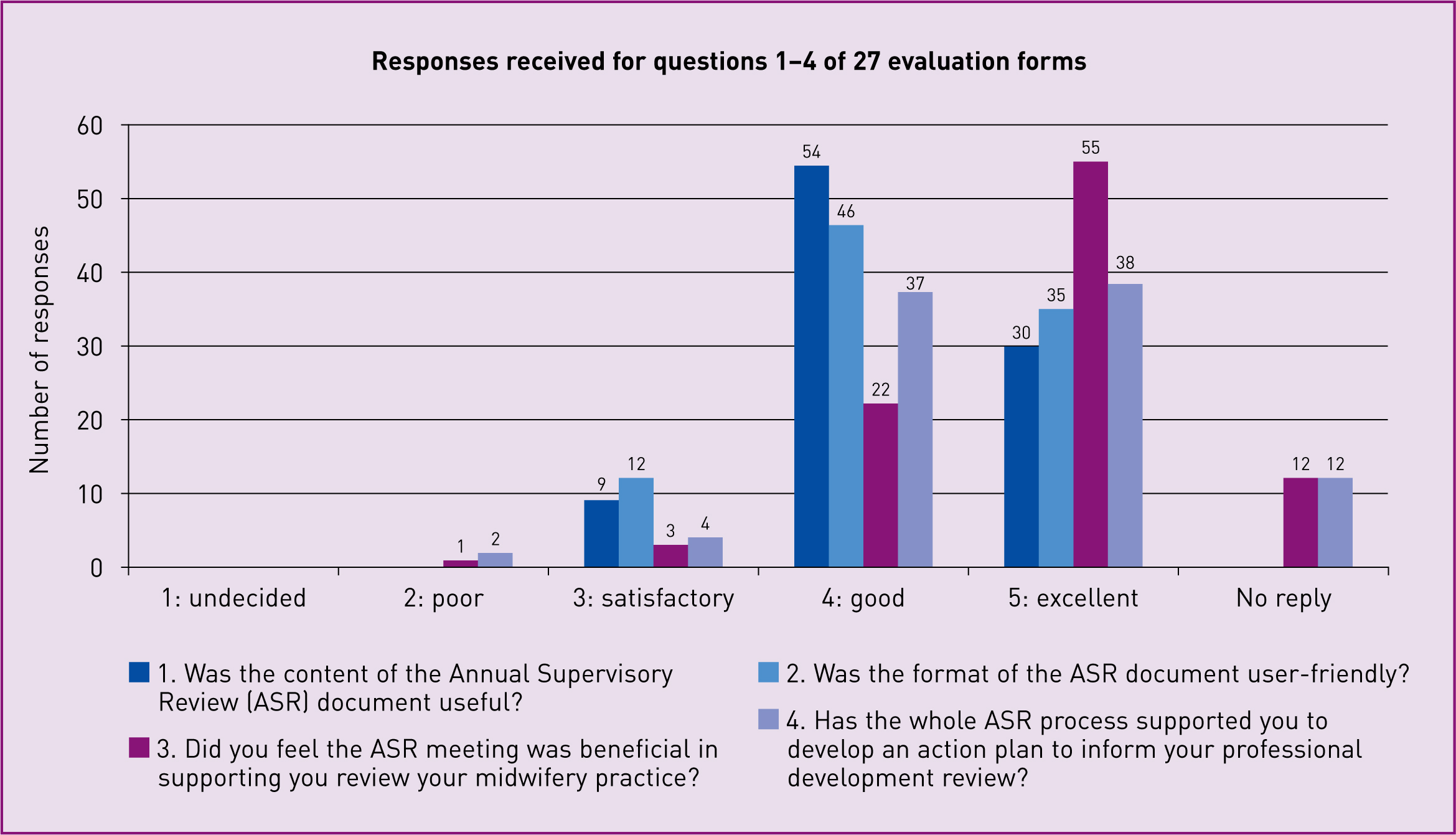
These findings are less positive than in the previous quarter, and there was a 50% reduction in evaluation forms submitted. It is difficult to explain this, but one explanation offered is that there may have been fewer ASR meetings during this quarter, or the analysis of the evaluation forms may have been delayed.
Overall, the findings from these evaluations are overwhelmingly positive in terms of group supervision as part of the Future Proofing Model of supervision of midwives in Wales. The findings, accrued over a 10-month period from 343 midwives, demonstrate clearly that midwives found the group meetings helpful in terms of supporting them to review their practice and to prepare their PDR, and should be considered as a valuable method of enhancing the revalidation process.
Conclusion
The report for Healthcare Inspectorate Wales (Darra, 2015) and this paper note that, while the purpose of establishing group supervision was initially task-orientated, unexpected benefits have been realised and have been positively received by midwives in Wales. Group supervision has been shown to support evidence-based practice, and professional development at the ASR is perceived as being better than expected, especially in terms of shared learning.
Group supervision should be considered as a valuable method of enhancing the revalidation process, as there are clear indications that the ASR held in a group setting has been perceived as particularly helpful in reviewing practice and preparing for personal/professional development reviews. There are also initial indications that group supervision may be a better mechanism for the protection of the public, with the sharing of best practice. With all of these benefits realised, interest in group supervision is growing in the rest of the UK, and Wales is proud to share this excellent innovation.

